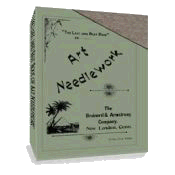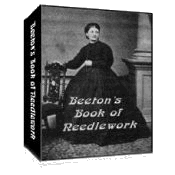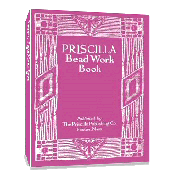Golden Rod Using Raised Embroidery
The Golden Rod, one of the most beautiful of all our autumn flowers, is essentially national in its character, as it grows from east to west and from north to south; in good soil and in barren and waste places. It is loved by the rich and poor alike, and is a golden glory always.
For purposes of embroidery, where bright rich color is desired, there is no other flower that can quite fill its place. It allows of graceful arrangements of form, and is susceptible of the most subtle graduations of light and shade. It is especially beautiful when combined with other autumn flowers – as sumac, thistles or asters – the rich purples and bright gold forming a piece of gorgeous coloring that will most effectually brighten up any dull corner.
Golden rod may be worked in several ways, either raised or flat, and the materials may be arrasene, chenille, rope, silk, filo floss or etching silk. **Please note** These directions are edited from Dainty Pleasures for Pleasure and Profit, 1902. Materials will have to be substituted for those no longer available.
To work with arrasene or chenille, commence at top edge of the highest branch of the golden rod and fill the surface of pattern with French Knots, using the palest shade at the top and shading to deepest gold on the under branches; when it is desired to raise the flower, rope silk or filo floss must be used. First fill the surface of the pattern with large French Knots of olive green rope silk; then, between each knot sew down thick strands of the silk, cut in lengths and crossed like the letter X; catch in the center of the X with a fastening stitch, pulling it down firmly, this will cause the ends of the strands of silk to spring up and cover the fastening stitches. Cover the surface of design thickly with the crossed strands of silk, which will be supported by the underfilling of French Knots, which will also afford that undershading of green seen in the natural flower.
To work a medium-sized branch of golden rod about four shades of filo floss will be required. When it is wished to work this flower on wash fabrics, the work should be done with two or three shades of yellow etching silk in French knots; make the knots smooth and even, winding the thread around the needle twice only; place the knots close together, but do not crowd them. Make as above described, the knots will not be much raised from the surface, and work thus treated will laundry perfectly. The foliage and stems of this flower should be worked with silver or lily green silk in Kensington stitch.
Return to top of Golden Rod Using Raised Embroidery page.
Return to Types of Embroidery page.
Return to Special Designs page.
Return to Home page.



 433 pages!
433 pages!

